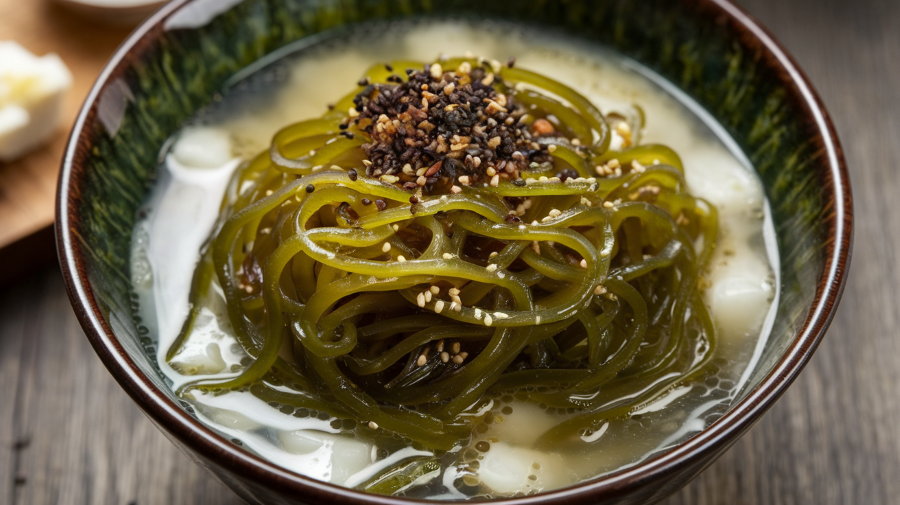Craving Asian noodle dishes but following a low-carb diet? You're not alone. Many people want to enjoy their favorite Asian foods while staying on track with their health goals. The good news is that there are tasty low-carb substitutes for traditional noodles: delicious alternatives for your favorite recipes.
Shirataki noodles, zucchini noodles, and daikon radish are great options to replace wheat-based noodles in Asian recipes. These low-carb alternatives let you enjoy the flavors and textures of your favorite dishes without the extra carbs. They work well in stir-fries, soups, and cold salads.
Incorporating low-carb substitutes for Asian noodle dishes can elevate your cooking and satisfy your cravings.
Using these substitutes can help you stick to a keto or low-carb eating plan. You'll still get to enjoy the rich flavors of Asian cuisine while keeping your carb intake low. This can support weight loss and better blood sugar control for some people.
Understanding Low-Carb Alternatives
Low-carb noodle options can help you enjoy Asian dishes while sticking to your diet goals. These alternatives offer health benefits and support weight loss efforts.

Role of Carbohydrates in Diet
Carbs are the main energy source for your body. They break down into glucose, fueling your brain and muscles. However, eating too many carbs can lead to weight gain and blood sugar spikes.
The keto diet limits carbs to put your body in ketosis. This makes you burn fat for fuel instead of carbs. Other low-carb diets also cut back on carbs, but not as strictly as keto.
Typical noodles are high in carbs. For example, 100 grams of rice noodles has 25 grams of carbs. Low-carb noodles let you eat your favorite dishes with fewer carbs.
Benefits of a Low-Carb Lifestyle
A low-carb diet can help you lose weight. It often leads to eating fewer calories overall. Your body also burns more fat when carbs are limited.
Low-carb eating may improve your health in other ways:
• Better blood sugar control
• Lower blood pressure
• Higher "good" HDL cholesterol
You might feel less hungry on a low-carb diet. Protein and fat can keep you full longer than carbs.
Low-carb noodles let you enjoy pasta-like dishes without the carb load. This makes it easier to stick to your low-carb or keto plan long-term.
Popular Low-Carb Noodle Alternatives
Low-carb noodle options can help you enjoy Asian dishes without the extra carbs. These alternatives offer similar textures and tastes to traditional noodles.
Zucchini Noodles (Zoodles)
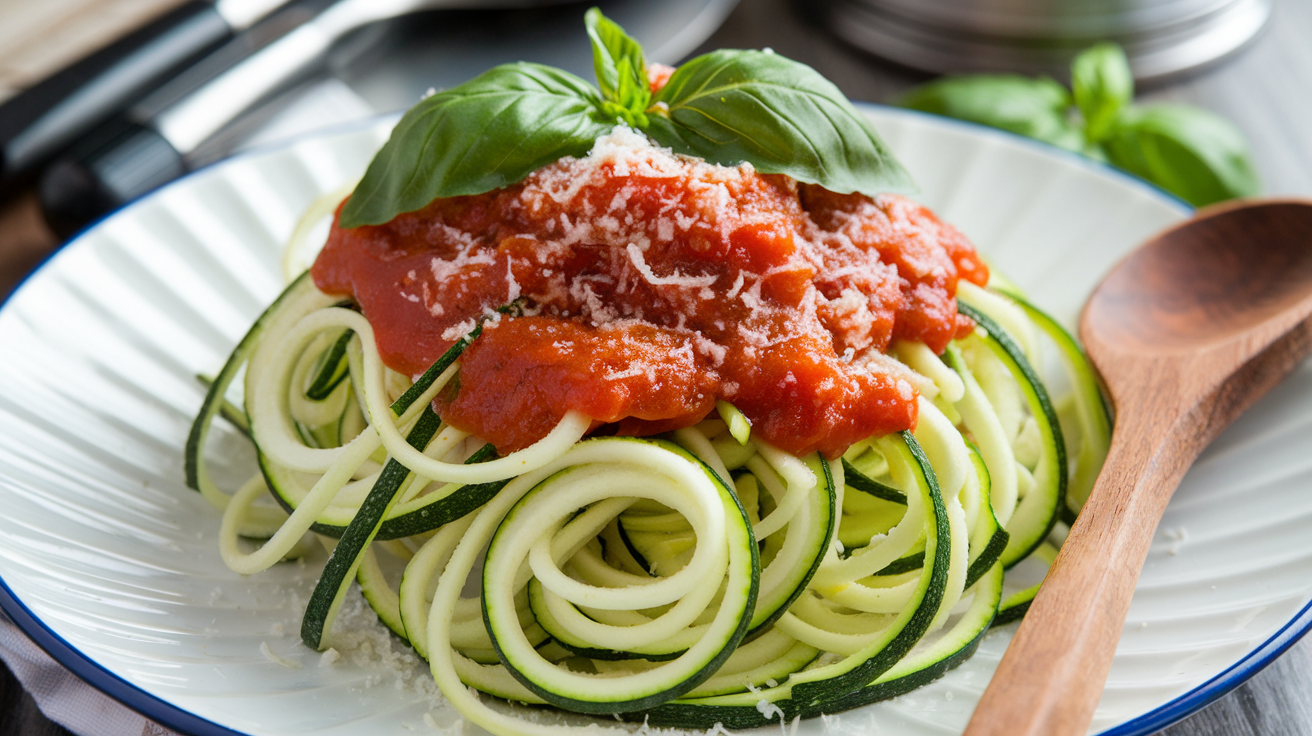
Zucchini noodles, or zoodles, are a tasty low-carb option. You can make them easily at home with a spiralizer. Simply cut zucchini into long, thin strips that look like noodles.
Zoodles have a mild flavor that works well with many sauces. They're great in stir-fries or cold salads. You can eat them raw or lightly cooked.
To prepare, sauté zoodles for 1-2 minutes. Don't overcook them, or they'll get mushy. Pat them dry before adding sauce to avoid watery dishes.
Shirataki and Miracle Noodles
Shirataki noodles are made from konjac yam. They're very low in calories and carbs. Miracle noodles are a type of shirataki noodle.
These noodles have a chewy texture. They don't have much flavor on their own but soak up sauces well. You can find them in different shapes, like spaghetti or fettuccine.
To use shirataki noodles:
- Rinse them well
- Boil for 2-3 minutes
- Dry-fry in a hot pan
They work great in Asian soups and stir-fries.
Vegetable Options
Many veggies can be turned into noodles. Options include:
- Carrot noodles
- Beet noodles
- Squash noodles
- Kelp noodles
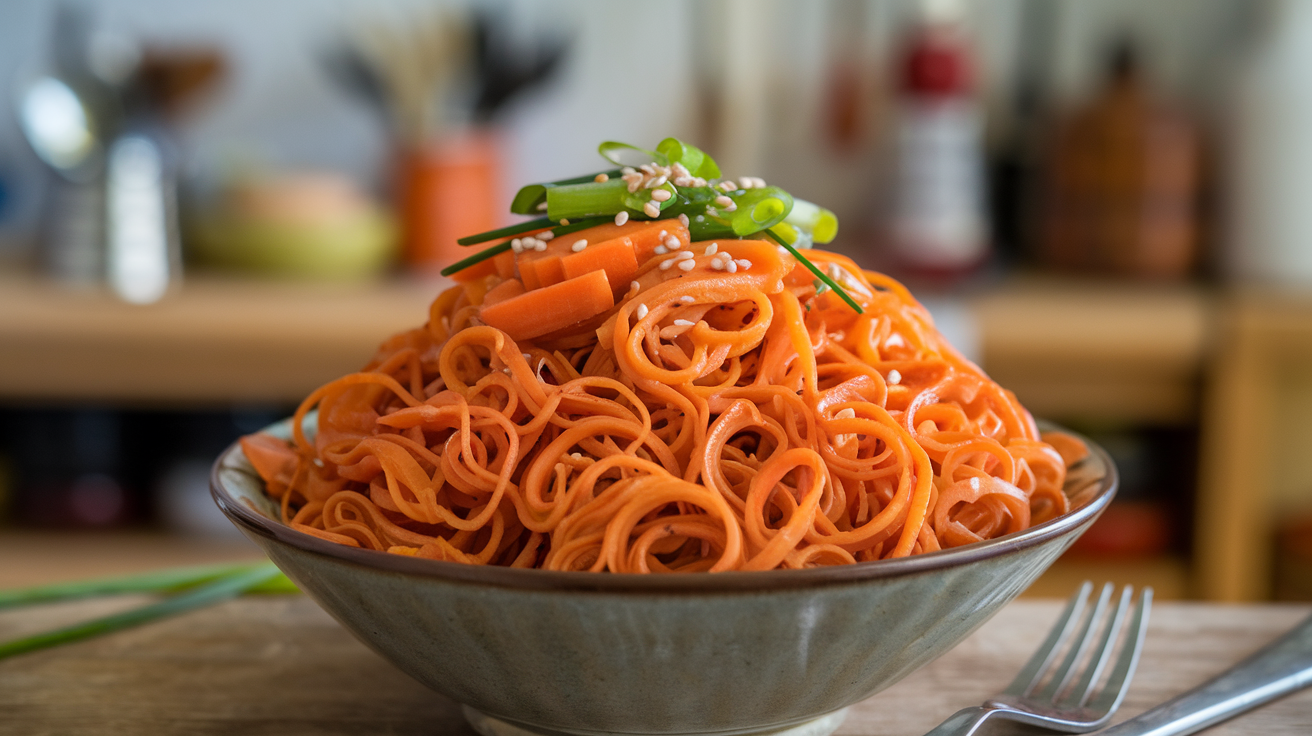
Kelp noodles are made from seaweed. They're crunchy and work well in cold dishes. Spaghetti squash is another good choice. When cooked, its flesh separates into spaghetti-like strands.
To make veggie noodles, use a spiralizer or vegetable peeler. You can also buy pre-spiralized veggies at many stores.
Commercial Keto-Friendly Noodles
Many brands now offer low-carb noodles. These often use ingredients like:
- Almond flour
- Coconut flour
- Egg whites
These noodles try to mimic the texture of wheat pasta. They usually have more protein than veggie noodles.
You can find these at health food stores or online. Follow the package instructions for the best results. They often work well in both hot and cold dishes.
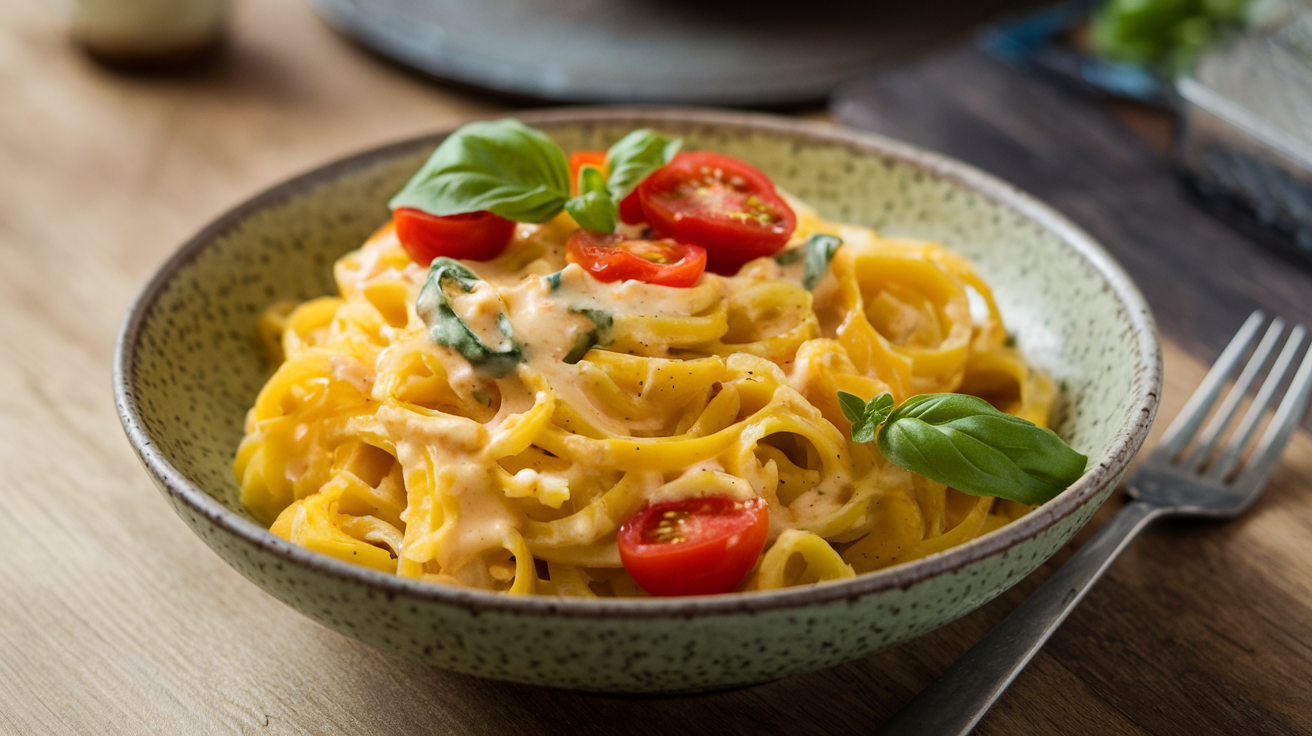
Essential Cooking Techniques and Tools
The right tools and techniques are key to making tasty low-carb noodle dishes. You'll need to master a few skills to get the perfect texture and shape.
Spiralizing and Mandolin Techniques
A spiralizer is your best friend for making veggie noodles. It turns zucchini, carrots, and other veggies into long, thin strands. To use it, trim the ends of your vegetable and secure it in the spiralizer. Turn the handle to create noodle-like spirals.
A mandolin slicer is great for making wider, flatter noodles. It cuts veggies into thin, even slices. Be careful - mandolins are very sharp. Always use the safety guard to protect your fingers.
For both tools, choose firm veggies for the best results. Softer produce can turn mushy.
Achieving the Right Texture
Getting the texture right is crucial for low-carb noodles. You want them tender but not soggy. For zucchini noodles, a quick sauté is often enough. Cook them in a hot pan with some oil for 2-3 minutes.
For firmer veggies like daikon or jicama, you might need to boil them briefly. Aim for an al dente texture - still a bit crisp. Test often to avoid overcooking.
Pat your veggie noodles dry before cooking to remove excess moisture. This helps them stay firm and absorb sauces better.
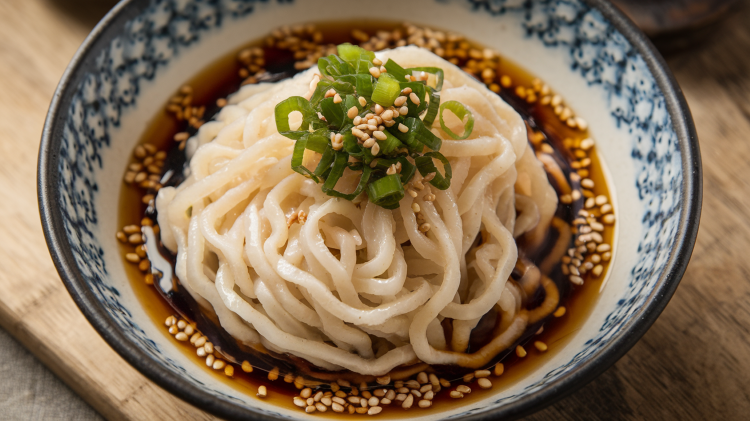
Incorporating Substitutes into Asian Cuisine
Low-carb noodle substitutes can be used in many Asian dishes. These swaps keep flavors authentic while cutting carbs. Let's explore how to use them in recipes, match them with sauces, and create tasty side dishes.
Altering Traditional Recipes
Try zucchini noodles in your next keto pad thai. Spiralize the zucchini and stir-fry it briefly. Add protein, eggs, bean sprouts, and peanuts. Mix in a sauce of fish sauce, lime juice, and a keto-friendly sweetener.
For keto Asian noodles, use shirataki noodles in soup dishes. Rinse them well and dry-fry to remove excess moisture. Add them to your broth with veggies and meat for a filling meal.
Cabbage makes a great noodle substitute in stir-fries. Shred it thinly and cook it quickly to keep some crunch. It soaks up sauces well and adds volume to your dish.
Matching Flavors and Sauces
Pair your noodle substitutes with bold Asian flavors. Ginger and chili are key ingredients that add heat and depth. Use them in stir-fry sauces or soups.
Make a keto-friendly peanut sauce with natural peanut butter, coconut aminos, and rice vinegar. This sauce works well with vegetable noodles or shirataki.
For a lighter option, try a sesame oil and rice vinegar dressing. It's perfect for cold noodle salads made with daikon or cucumber strips.
Remember to taste as you go. Low-carb substitutes may need more seasoning than traditional noodles to carry flavors well.
Side Dishes and Salads
Create a refreshing Asian slaw using shredded cabbage, carrots, and daikon. Dress it with a mix of rice vinegar, sesame oil, and a touch of sweetener.
For a warm side, stir-fry bean sprouts with garlic and ginger. They offer a nice crunch and are naturally low in carbs.
Make a cold noodle salad using kelp noodles. Toss them with cucumber, cilantro, and a spicy lime dressing. This dish is light and refreshing.
Don't forget the cultural significance of noodles in Asian cuisine. While using substitutes, try to keep the spirit of the dish intact. This shows respect for the
food's origins.

Nutritional Information of Low-Carb Substitutes
Low-carb noodle alternatives offer impressive nutritional profiles. They provide essential vitamins, minerals, fiber, and protein while keeping carbs in check.
Vitamins and Minerals Content
Many low-carb noodle substitutes are rich in vitamins and minerals. Zucchini noodles pack vitamin C, which boosts your immune system. A medium zucchini provides over 50% of your daily vitamin C needs.
Cabbage noodles offer vitamin K for blood clotting and bone health. They also contain vitamin C and folate.
Shirataki noodles have few vitamins, but they're very low in calories. This makes them a good choice if you're watching your weight.
Konjac noodles contain small amounts of iron, calcium, and phosphorus. These minerals support healthy bones and energy production.
Fiber and Protein Contributions
Low-carb noodle alternatives can be great sources of fiber and protein. Zucchini noodles provide about 1 gram of fiber per cup. This helps keep you full and aids digestion.
Cabbage noodles offer 2 grams of fiber per cup. They also contain 1 gram of protein.
Shirataki noodles are mostly water and fiber. A 3-ounce serving provides 3 grams of fiber. This can help you feel satisfied with fewer calories.
Konjac noodles are very high in fiber. A 3-ounce serving contains 3 grams of fiber. This promotes gut health and helps control blood sugar.
Conclusion
Low-carb noodle substitutes offer tasty options for Asian dishes. You can enjoy your favorite meals while sticking to a low-carb diet. Zucchini noodles, shirataki noodles, and konjac rice noodles are great choices.
These alternatives work well in stir-fries, soups, and salads. They soak up flavors and provide similar textures to traditional noodles. You won't feel like you're missing out on your favorite Asian dishes.
Experiment with different low-carb noodles to find your favorites. Each type has its own unique qualities. You might prefer the crunch of vegetable noodles or the chewiness of konjac noodles.
Remember to pair your low-carb noodles with plenty of vegetables and lean proteins. This will create filling, nutritious meals. You can still enjoy the flavors of Asian cuisine while maintaining a healthy lifestyle.


